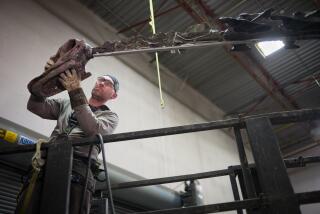Dinosaur--on Wing and a Cheer : 225-Million-Year-Old Bones, Believed Oldest, Flown to UC
- Share via
PETRIFIED FOREST NATIONAL PARK, Ariz. — The skeleton of a 225-million-year-old dinosaur, believed to be the oldest remnant ever found of the huge reptiles, was lifted by helicopter from a desert wash here Thursday and flown to the University of California, Berkeley, for scientific study.
At UC Berkeley a team of paleontologists will reconstruct the skeleton over the next six months and analyze its structure for clues about the creature’s behavior and its environment.
The morning airlift, watched by hundreds of tourists and area residents, was dramatic evidence of a five-year research project here that scientists predict will eventually yield the most complete picture of the dawn of the dinosaur age.
“We are very excited about the dinosaur,” said Robert Long, a UC paleontologist who heads the research project. “But what’s far more exciting is the stuff that is still out there. We think we’ve got the fossil records of the whole thing--plants, animals, even insects. There’s no place on earth like it.”
Indeed, since the announcement of the discovery last month, almost everyone in this rural region seems to have caught dinosaur fever. So many people got up early Thursday morning to see the airlift that park rangers had to manage a rare occurrence here: a traffic jam. And when the remnant, encased in a plaster mold, was gently deposited onto a landing area, the onlookers burst into applause.
By most measures, the new dinosaur skeleton is an unusual representative of its kind. Far from rivaling the mammoth beasts that were to follow, this early dinosaur was very small, about the size of a large dog. Scientists now estimate that it weighed about 75 pounds and was likely a plant-eater.
Nonetheless, an artist’s rendering of the creature made by a member of the UC team clearly shows a resemblance to later dinosaurs, though in miniature.
“It had a long neck, a small head and was rather stupid,” said Long, a bearded, effervescent man who has nicknamed the discovery “Gertie.” A scientific name will be added after the skeleton has been analyzed.
The skeleton was dated by taking ancient pollen samples from surrounding rock and comparing them to similar pollen from European sediments whose age is known. This method, the scientists say, is highly accurate and makes the dinosaur 5 million to 10 million years older than any skeleton found before.
Older Dinosaurs Possible
Skeletal fragments that may be part of even older dinosaurs have been found in other parts of the world and in deeper sediments of the petrified forest here. But, the paleontologists say, such fragments are so small that they cannot be used to construct an animal’s characteristics or establish for certain that they belong to the dinosaur family.
“Whenever you say something is the oldest or the newest, there’s bound to be doubters in the scientific community,” said William Barry, chairman of the Department of Paleontology at UC Berkeley. “But we have a lot of confidence in these dates.”
The discovery of the fossil last summer was partly a result of luck. At the very end of the season, Long dispatched two graduate students to make a last tour of a bleak wash about a quarter of a mile from a popular tourist viewpoint in the park. One of the students, Bryan Small of Texas Tech University, noticed what he described as “some little bones” lying on the surface.
“At first I didn’t think much about it,” Small said. “But then I took a closer look, and I knew I wasn’t dealing with the usual primitive reptile. I had this excited, good feeling and I went to get Rob Long.”
Skeleton May Have Perished
If Small had not noticed the skeleton, it might have been lost forever, the scientists now say. Such bones are extremely fragile and begin to disintegrate almost immediately when exposed to the air. A dinosaur bone rarely lasts more than a few months at the surface, they say.
The excitement of the discovery has spread to the nearby town of Holbrook. Dinosaur art now stares back at visitors from restaurant windows and gas stations in the town, giving the main street something of an eerie look. And this week, Holbrook invited everyone within calling distance to a reception at the courthouse for the scientists and the National Park Service.
In fact, without Holbrook the discovery of the dinosaur might never have taken place. In the five years of the research project, a large share of its financial needs have been supplied by a local group known as The Petrified Forest Museum Assn.
“I’m not sure anything this big has ever happened to Holbrook,” a local housewife at the reception said. “The only thing that comes close was the time (actor) Henry Winkler rode through town in a limo.”
Research to Continue
Meanwhile, scientists say that the research here will likely continue for at least another five years. If they are successful, the scientists say, they will be able to describe for the first time a world in which one biological era was ending and another beginning during the Triassic period.
“This was a time before flowers, before mammals,” said Chris Andress, the park’s chief ranger. “There were huge reptiles that ruled this world, but they were dying out. And the dinosaurs were moving in.”
According to Long, those older reptiles were more primitive than dinosaurs but were still very impressive. They included crocodile-like animals that grew to 35 feet and weighed 10 tons.






